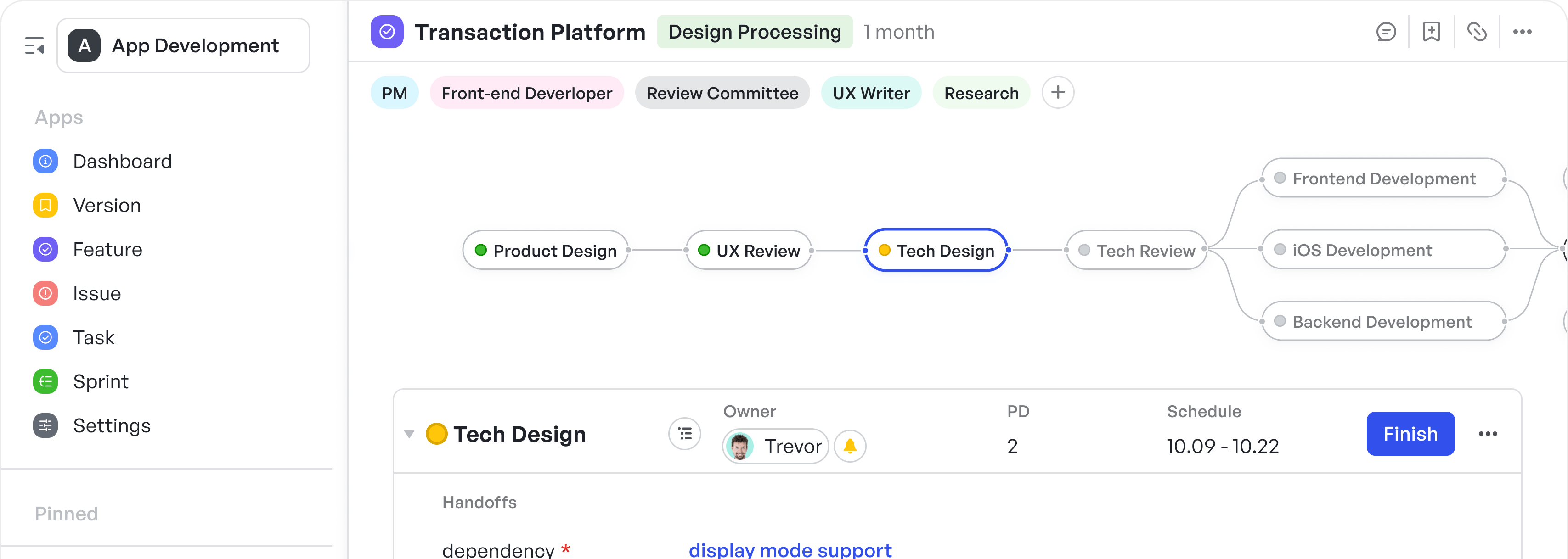Creating products is a journey from conceiving good ideas to bringing them to life. This is where an Agile product roadmap comes in. It’s a guide that helps you and your team understand where your product is going, without locking you into rigid plans that might not make sense tomorrow.
Whether you're building a new app, improving a service, or launching a website, a good roadmap keeps everyone moving in the same direction while staying flexible enough to adapt when things change. It's a GPS that recalculates the route when you need to take a detour.
What Is an Agile Product Roadmap?

250px|700px|reset
An Agile product roadmap is a living document that shows the general direction of your product's development. Unlike traditional roadmaps that might lay out exact features and dates for the next year, an Agile roadmap focuses on goals and outcomes while staying flexible about the exact path to get there.
Key elements of an Agile roadmap include:
- Clear product goals that explain what you want to achieve
- Broad time horizons (like "now," "next," and "later") instead of specific dates
- Customer problems you're trying to solve
- Major themes or areas of focus
Think of it like planning a road trip. You know your destination and some major stops along the way, but you're open to taking different routes or making unexpected discoveries during the journey.
The real power of Agile roadmaps comes from what they do for your team and stakeholders:
- Give everyone a shared vision of where the product is heading
- Help teams understand why they're building certain features
- Make it easier to adapt plans when market conditions or customer needs change
- Keep everyone focused on delivering value rather than just completing tasks
When to Use Agile Roadmaps
Agile roadmaps work best in situations where change is expected and flexibility is valued. They're particularly useful when:
Your market moves quickly
You need to respond to changes in customer needs, competitor actions, or new technologies. An Agile roadmap helps you stay nimble while keeping your overall goals in sight.
You're learning as you go
When you're building something new or entering unfamiliar territory, an Agile roadmap lets you adjust your plans based on what you learn from customers and early releases.
Teams need autonomy
Agile roadmaps work well when you want to give teams the freedom to figure out the best solutions, while still ensuring everyone's working toward common goals.
In practice, Agile roadmaps fit naturally with Agile development methods. They support the Agile principle of responding to change over following a plan. Using Meegle's visual workflow tools, teams can:
- Create and update roadmaps easily
- Share progress with stakeholders
- Adjust plans based on new information
- Keep everyone aligned on priorities
The goal isn't to predict the future perfectly but to become adept at taking advantage of new opportunities or handling unexpected challenges.
What Does an Agile Roadmap Look Like?
250px|700px|reset
加载中,请稍后
An Agile roadmap looks different from traditional project plans. Instead of a rigid timeline with specific dates, it's organized into broad time horizons that give you room to adapt. Picture it as a high-level view of your product journey, broken down into manageable chunks.
Most Agile methodology roadmaps have three main time horizons:
Now (Current Quarter)
This is your immediate focus. It shows what your team is working on right now and what you'll tackle in the next few weeks. The details here are clearer and more specific than other sections.
Next (Coming Quarter)
This section outlines what's coming up soon. The plans here are less detailed but show clear direction. You might list major features or improvements you want to work on, but stay flexible about exactly how you'll build them.
Later (Beyond Next Quarter)
This is your long-term vision. Here you'll find broader goals and ideas that might change as your product managers learn more. Think of it as your "north star" - showing the direction you're heading without locking in specific details.
Each section of your roadmap typically includes:
- Goals: What you want to achieve
- Themes: Major areas of focus
- Expected outcomes: How you'll measure success
- Dependencies: What needs to happen first
How to Create an Agile Roadmap
250px|700px|reset
加载中,请稍后
Creating an Agile roadmap is about finding the right balance between planning ahead and staying flexible. Here's how to build one:
Start With Strategy
Begin by understanding your product strategy and business goals. Ask yourself:
- What problems are we solving for customers?
- What makes our product different from competitors?
- Where do we want the product to be in 6-12 months?
Write these down — they'll guide every decision you make about what goes into your roadmap.
Gather Input
Talk to different groups to understand their needs:
- Customers: What problems do they need solved?
- Sales team: What features would help them sell better?
- Support team: What issues do customers keep reporting?
- Development team: What technical improvements are needed?
Using Meegle, you can collect and organize all this feedback in one place, making it easier to spot patterns and priorities.
Set Clear Goals
For each time horizon, define what you want to achieve. Instead of listing specific features, focus on outcomes. For example:
- "Make it easier for new users to get started"
- "Reduce customer support requests"
- "Improve loading speed"
Organize Into Themes
Group related work together into themes. This helps everyone understand the bigger picture. A theme might be:
- User Experience Improvements
- Performance Optimization
- New User Features
Keep it Simple
Avoid getting too detailed, especially for items further in the future. Build an agile roadmap that fits on one page or screen. Remember, details belong in your sprint planning, not your roadmap.
Review and Adjust
Set regular times to review and update your roadmap. As you learn more about what customers want and what works, adjust your plans. Use Meegle's visual tools to make updates easy to track and share.
Best Practices:
- Focus on customer value over features
- Use clear, simple language everyone can understand
- Leave room for unexpected opportunities
- Keep the format visual and easy to scan
- Share updates regularly with your team
Your progress-based roadmap should tell a story about where your product is going and why. When done right, it helps everyone understand their part in the bigger picture while staying flexible enough to adapt when things change.
Epics Roadmap Template for Agile Teams
250px|700px|reset
加载中,请稍后
Meegle screenshot showing Epic list with features and issues
In Agile teams, epics are large chunks of work that can be broken down into smaller tasks. Think of an epic like "Improve User Onboarding" - it's too big to complete in one sprint, but it gives a clear direction for what needs to be done.
An epics roadmap helps you organize these big pieces of work over time. Instead of saying "we'll launch feature X on July 1st," you might say "we'll focus on user onboarding this quarter." This approach gives your team room to adapt while still maintaining a clear direction.
A good epics roadmap template includes:
- Epic name and brief description
- Business value and expected outcomes
- General timeframe (Now/Next/Later)
- Dependencies between epics
- Key milestones to track progress
Building the Roadmap
250px|700px|reset
加载中,请稍后
Creating an epics roadmap starts with understanding your big-picture goals. What matters most for your product right now? What do your customers need? Here's how to build it step by step:
Start with Customer Needs
Write down the main problems your customers face. These become the foundation for your epics. For example, if customers struggle to get started with your product, "Simplify First-Time User Experience" might be an epic.
Define Your Epics
For each major customer need:
- Write a clear description
- List expected benefits
- Note any dependencies
- Estimate rough size (small, medium, large)
Using Meegle's visual tools, you can map these epics across your timeline. The platform helps you:
- Arrange epics in order of priority
- Show connections between different pieces of work
- Track progress as teams complete parts of each epic
- Adjust your internal roadmap as things change
250px|700px|reset
加载中,请稍后
Meegle's agile roadmap interface will show you a hierarchical view of project planning
Sharing the Roadmap
A roadmap only works if people understand and use it. Here's how to share it effectively:
Make it Visual
Use Meegle's dashboard features to create clear visual representations of your development efforts. This helps everyone quickly understand:
- What work is happening now
- What's coming up next
- How different epics connect
- Overall progress toward goals
Keep Different Audiences in Mind
Different groups need different levels of detail:
- Executives want to see business outcomes
- Development teams need technical context
- Sales teams want to know about new features
Regular Updates
Set a rhythm for roadmap updates:
- Weekly check-ins on current epics
- Monthly reviews of priorities
- Quarterly planning for future epics
Use Meegle's collaboration features to:
- Share updates automatically
- Collect feedback from key stakeholders and user stories
- Track product vision changes over time
- Keep product teams aligned on priorities
250px|700px|reset
加载中,请稍后
Use Meegle's Schedule view interface to look at team resource management
Your agile methodologies are communication tools that help everyone understand where you're going and why. Keep it simple, visual, and focused on outcomes rather than specific features.
The key to success is finding the right balance between detail and flexibility. Too much detail makes the roadmap rigid and hard to change. Too little detail, on the other hand, will leave your agile team confused about priorities. Using a tool like Meegle helps you strike this balance by making it easy to adjust plans while keeping everyone informed.
Using the Roadmap
A roadmap is only valuable if you actually use it to guide your work. Let's look at how to make your roadmap a practical tool, not just a document that sits in a folder somewhere.
Make it Part of Your Rhythm
Start each week by checking your roadmap. Are you still working on what matters most? During your team's daily stand-ups, keep the roadmap visible in Meegle's dashboard. This helps everyone connect their daily work to bigger goals.
When discussing new ideas or requests, always refer back to your roadmap. Ask yourself: "Does this fit our current priorities? Should we adjust our plan?" This keeps random requests from derailing your progress.
Track Progress Naturally
Instead of creating extra work, use your normal development process to update the roadmap. In Meegle, you can:
- Link daily tasks to larger epics
- See how completed work adds up
- Spot when things are getting off track
- Share progress automatically with stakeholders
Keep Teams Aligned
Help everyone understand their part in the bigger picture:
- Show developers how their code connects to user benefits
- Help designers see how their work fits into upcoming epics
- Let support know whether improvements are reflected in customer feedback
Evolving the Roadmap
Your roadmap should change as you learn more. Here's how to keep it relevant without causing chaos.
Regular Review Cycles
Set up a simple review schedule:
- Weekly: Quick check on current work
- Monthly: Look at priorities for next quarter
- Quarterly: Big-picture review of all horizons
When making changes, ask:
- What have we learned from customers?
- Has anything important changed in the market?
- Are our current priorities still right?
- Do we need to adjust our timing?
Using Meegle, you can:
- Track changes to the roadmap over time
- See how estimates compare to reality
- Adjust plans based on real data
- Keep everyone updated automatically
How Meegle Fits into Agile Roadmap Management
Agile roadmapping becomes more powerful when supported by the right tools. Meegle transforms roadmaps from static documents into dynamic, visual guides that keep teams focused on what matters most. Here’s how.
Powerful insights with Meegle's charts
250px|700px|reset
加载中,请稍后
Harness instant insights through Meegle's charts
The Visual Workflow Dashboard sits at the heart of Meegle's roadmapping capabilities. Instead of wading through spreadsheets or presentation slides, you can see your product journey as an interactive map. With Meegle’s charts, you get:
- Interactive dashboards with pie, line, and bar charts for instant visualization
- Customizable templates to match your workflow needs
- Real-time sprint tracking with velocity and burn rate metrics
- Team performance monitoring and workload optimization
- Custom formula creation for targeted analysis
- Customer retention insights with proactive risk detectionClear, shareable reports that update in real-time
Your current priorities, progress, and upcoming work all appear in clear, visual formats that everyone can understand at a glance. As your priorities change, so do the charts. Daily stand-ups become easier and teams spot potential issues before they become problems.
Get updated instantly using different Views
250px|700px|reset
加载中,请稍后
Get a bird's-eye view of your project
Meegle's Panorama View offers something special — a bird's-eye view of your entire product journey. Think of it as stepping back to see the whole landscape of your project. This view proves invaluable during:
- Quarterly planning sessions
- Stakeholder presentations
- Team alignment discussions
Compartmentalize easily with the Tree View
250px|700px|reset
加载中,请稍后
Fuel progress with the big picture of all the projects with Meegle's Tree View
The Tree View brings a new dimension to roadmap organization. It helps you break down big initiatives into manageable pieces while keeping sight of how everything connects. Teams can easily see their part in the bigger picture, and leaders can track progress at every level without getting lost in details.
Deploy faster with release and version management
250px|700px|reset
加载中,请稍后
Track releases with ease on Meegle
Meegle's list view creates a clear map from big goals down to specific bugs. Rather than juggling multiple tools to track a release, everything's organized in one place.
Here's how it speeds things up with your product releases:
- Spot problems fast: See what's blocking releases at a glance
- Quick handoffs: Easily assign work and track who's doing what
- Clear priorities: Know exactly what needs to happen next
- Connected updates: When something changes, related items update too
- Smart resourcing: Quickly see where to add help when needed
Basically, less time hunting for information means more time actually shipping code. Everything's connected and visible, so we can move faster while keeping quality high.
Meegle also helps teams with version management. Maintain clear control over product versions by connecting customer feedback directly to development. Here's how:
- Track customer input and feature requests by version
- Prioritize updates with drag-and-drop Kanban organization
- Break version updates into clear, manageable tasks
- Adapt version roadmaps based on real-time market needs
- Coordinate version releases across teams efficiently
250px|700px|reset
加载中,请稍后
Implement Agile with Meegle
Well-managed agile product roadmaps help teams deliver better products by keeping everyone focused and aligned while staying flexible enough to adapt to change. Meegle makes this easier by providing the visual tools and tracking features teams need to make their roadmap a living part of their daily work.
The key to success lies in:
- Making your product roadmap part of daily discussions
- Keeping it simple and visual
- Updating it as you learn new information
- Using it to guide decisions, not dictate them
With Meegle's support, maintaining and updating your agile product roadmap becomes a natural part of product development rather than an extra burden on your team.





